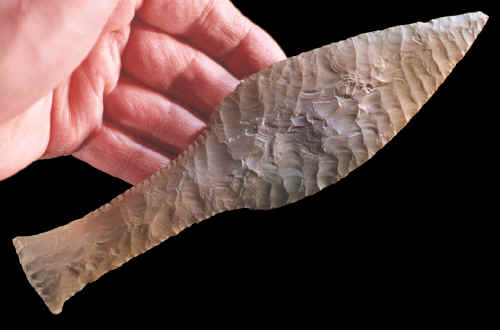|
TYPE V
DANISH DAGGER
NORTHERN EUROPE
PRIVATE COLLECTION
COPYRIGHT
FEBRUARY 28, 2006 PETER A. BOSTROM

CAST ILLUSTRATED
CAST
#N-7
TYPE V DANISH DAGGER
NORTHERN EUROPE
PRIVATE COLLECTION
By
Errett Callahan, Ph.D.
This is a fairly typical example of a Type V Danish Late Neolithic flint
dagger. This type signifies the termination of the Neolithic period,
though one additional type (VI) follows in the Early Bronze age. After
that, the use of flint in Denmark decreases drastically.
The Type V dagger is similar in outline to the Type IV,
except that much more variation is noted in the handle shape. Also,
there is no zig-zag seam running down the length of the handle. The
handle does have a flared base similar to the Type IV, but neither the
retouch nor the flaking of the body of the handle is as tightly
structured as with the Type IV. Furthermore, the very base itself may be
either squared or not (i.e. with two edges or one). The examples here
shows the more common, squared type base.
The blade varies less from the type IV than the handle
does, both in outline and flaking quality. While both percussion and
pressure finishing are observed, pressure, such as on this example,
usually predominates. One encounters less of the straight-in pressure
flaking style so common on the Type IV and more of the diagonal
varieties common on the other dagger types.
This particular blade is fairly well flaked, especially
considering its width. The overall size is fairly typical of the type
being somewhat smaller than the Type IV.
The warm-hued patina on this example shows that this piece
was probably recovered from a bog and may therefore have been an
offering. Usually only bog finds reflect such warm colors due to
infiltration of the iron oxides in the bogs.
|
